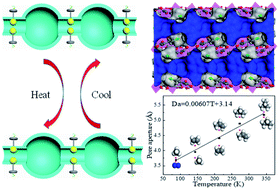A temperature-responsive smart molecular gate in a metal–organic framework for task-specific gas separation†
Abstract
Molecular sieving is a highly efficient method for gas separation because of its ultra-high selectivity. Nevertheless, traditional adsorbents with a molecular sieving effect can only separate a specific gas mixture due to their constant pore apertures. It is still a challenge to continuously fine-tune pore apertures at the sub angstrom scale to separate various gas mixtures in a given porous material. Herein, a temperature-responsive smart molecular gate with a precisely controllable pore size is proposed and validated for molecular recognition and separation, achieved by introducing methoxyl groups into the narrow bottleneck of a metal–organic framework (MOF). The effective aperture size of a smart molecular gate can be continuously tuned from 3.6 to 5.2 Å, covering the size range of commercially important gas molecules. Consequently, the MOF with such a structure exhibits highly selective uptake of several gas mixtures, including N2/CH4, CH4/C2H4, C2H4/C3H6, C3H6/C3H8, and C3H8/i-C4H10, by controlling the opening degree of the smart molecular gate. Furthermore, to verify its practical application, C3H6/C3H8 separation performance was systematically evaluated, and excellent selectivity for C3H6/C3H8 can be achieved at room temperature. This rational design of a smart molecular gate in this work opens a new avenue for the application of smart materials for gas separation.



 Please wait while we load your content...
Please wait while we load your content...